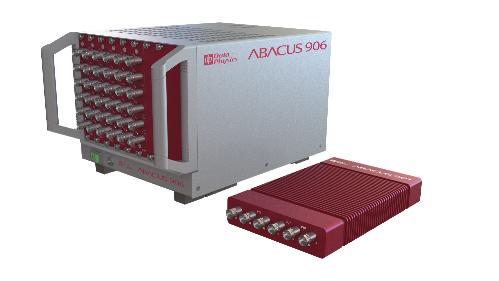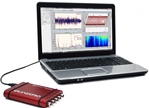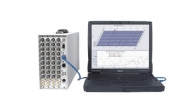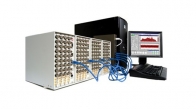 Data Physics SignalCalc Dynamic Signal Analyzers provide highly accurate measurements in the time, frequency, amplitude, and order domains. You can choose a range of hardware platforms from the pocket-sized ACE to the new Abacus combined with your preferred computer platform to configure a state-of-the-art solution for any dynamic signal analysis application. SignalCalc dynamic signal analyzers offer connectivity across networks and applications, consistency of the intuitive user interface design across all products, and compatibility of data and results with industry standards ensuring efficient interchange with other popular design and analysis programs. ACE SignalCalc Dynamic Signal Analyzers
Data Physics SignalCalc Dynamic Signal Analyzers provide highly accurate measurements in the time, frequency, amplitude, and order domains. You can choose a range of hardware platforms from the pocket-sized ACE to the new Abacus combined with your preferred computer platform to configure a state-of-the-art solution for any dynamic signal analysis application. SignalCalc dynamic signal analyzers offer connectivity across networks and applications, consistency of the intuitive user interface design across all products, and compatibility of data and results with industry standards ensuring efficient interchange with other popular design and analysis programs. ACE SignalCalc Dynamic Signal Analyzers
900 serie SignalCalc Dynamic Signal Analyzers
 New 2015 ! :Introducing Data Physics 900 Series Dynamic Signal Analyzers
New 2015 ! :Introducing Data Physics 900 Series Dynamic Signal Analyzers
Powered by ABACUS
The Data Physics 900 Series Dynamic Signal Analyzers integrate comprehensive signal analysis capabilities with a new distributed real-time signal processing engine to provide extraordinary dynamic testing capabilities. Compact and rugged, the 900 Series hardware is designed for demanding field applications. With a modular, gigabit Ethernet architecture, the 900 Series can be expanded to over 1,000 channels for laboratory use.
The 900 Series Dynamic Signal Analyzer, using all-new 900 Series SignalCalc software, offers signal analysis solutions for a wide range of dynamic testing applications:
- General FFT Analysis
- Data Acquisition and Waterfall Analysis
- Throughput Recording & Playback Analysis
- Structural Analysis
- Acoustic Analysis
- Rotating Machinery Analysis
- Environmental Test Data Analysis
Simplified Test and Analysis
The new SignalCalc 900 Series software makes the process of defining a test, making measurements, analyzing data and generating high-quality reports easier than ever before.
- Manage tests and data using the built-in relational database
- Streamline testing by running multiple simultaneous real-time measurements
- Define custom real-time signal processing functions using mathematical operations, including, integration, differentiation, addition, subtraction, multiplication, division, matrix operations, filters (low pass, high pass and band pass), Fourier Transform, Inverse Fourier Transform
- Generate high-quality custom reports
Modular, Scalable Hardware
The new Abacus 900 Series hardware platform is a powerful, real-time, distributed digital signal processing system. The gigabit Ethernet network architecture allows the systems to be used independently or combined to create larger systems with over 1,000 channels. Systems are comprised of channel cards with up to six channels per card. Two channels on each card are reconfigurable by the user as inputs, outputs or tachometers allowing the system to be configured as needed for each test.
- Up to 216 kSamples/s for 80 kHz of alias-free bandwidth
- 24-bit analog-to-digital conversion with up to 150 dB dynamic range
- Channel-to-channel phase accuracy of better than 0.5 deg at 40 kHz
DATAPHYSICS SignalCalc 900 - Analyzer System Brochure
 SignalCalc ACE
SignalCalc ACE
Powered by Quattro
Ultra-Portable, Cost-Effective, Dynamic Signal Analyzers
The SignalCalc Ace weighs just over a pound, and packs an unprecedented signal
processing punch: four input channels, two output channels, one tachometer channel, 40 kHz
standard realtime rate (94 kHz optional), and over 120 dB dynamic range. Ace transforms any
Notebook computer into a high precision dynamic signal analyzer, one that can travel with
you and work professionally — even in the absence of line power.
- 4 input channels, 2 sources SignalCalc
- Dedicated high speed tachometer input
- 120 dB dynamic range
- 40 kHz realtime bandwidth (94 kHz optional)
- Intuitive software interface
- Rugged and reliable design
Powered by Quattro
Portable and rugged, the SignalCalc Ace is powered by the Quattro hardware platform. Quattro provides USB 2.0 connectivity to a host PC or laptop and is completely bus powered. With realtime analysis capability from DC to 93 kHz (204.8 kHz optional sample rate), the Quattro provides 32 bit floating-point DSPs. All inputs are coupled to dedicated 24 bit sigma-delta ADCs while both outputs have 24 bit DACs. Integral anti-aliasing filters protect the inputs and outputs. This horsepower provides over 120 dB dynamic range with up to 94 kHz real-time rate.
Perfect for any Application
Quattro, with 4 inputs, 2 outputs, and a dedicated tachometer input, provides a powerful backbone for the most demanding applications. Ace performs analysis in the time, frequency, order and amplitude domains. Use synchronous averaging to recover repetitive events buried in noise. Correlate signals to discover their similarity and temporal alignment. Use FFT spectrum analysis to identify dominant frequencies and spectral density levels. Characterize linear systems by their Transfer, Coherence and Impulse Response functions.
SignalCalc Ace core functions include powerful FFT measurements, high dynamic range, and extensive analysis tools. Standard functions include full Engineering Units selection and conversion, Automatic Export, Professional Reports, easy data management with Signal Map, flexible display of results, cursor functions for detailed analysis, and an unsurpassed intuitive user interface.
Optional application modules extend the functionality to include real-time Octave and 1/3 Octave analysis, Sound Power and Intensity, RPM-based measurements, Order Tracking, MIMO and Stepped Sine testing, Balancing, SRS analysis, Demodulation, Rotordynamics analysis, multi-plane Balancing, Waterfall and Spectrogram presentations, Throughput-to-Disk, Zoom and High-Resolution FFT analysis.
Simply load the software, connect the USB cable between Quattro and the PC and it is ready to begin measurement.
DATAPHYSICS SignalCalc ACE - Analyzer System Brochure
Analyseurs de vibrations SignalCalc MOBILYZER
Modular and Expandable Portable Dynamic Signal Analysis
SignalCalc Mobilyzer provides dynamic signal analysis capabilities in the lab or on the go with a portable and powerful package. With up to 32 inputs, plus 8 tachometer inputs per chassis, the Mobilyzer empowers the vibration analyst to get measure all necessary information with simultaneous sampling.
go with a portable and powerful package. With up to 32 inputs, plus 8 tachometer inputs per chassis, the Mobilyzer empowers the vibration analyst to get measure all necessary information with simultaneous sampling.
- 8-32 input channels, 2-8 sources
- 2-8 dedicated tachometer inputs
- Up to 150 dB dynamic range
- 49 kHz analysis bandwidth (97 kHz optional)
- Intuitive software interface
- Powerful multi-channel analysis and features
Powered by Abacus
SignalCalc Mobilyzer runs on the legendary Abacus dynamic signal analysis hardware, a compact network peripheral that brings the power of distributed DSP architecture to the field and laboratory. Abacus distributes the processing load to achieve high speed, high quality signal analysis, and interfaces to a notebook or desktop computer via a standard Ethernet connection. The Abacus chassis contains a Pentium CPU controlling multiple data acquisition and signal processing modules. The architecture is optimized for efficiency by dedicating a high speed DSP to each group of channels. This ensures that processing speed is maintained at the same high rate regardless of the number of channels in use.
With up to 32 input channels, 8 output channels, and 8 tachometer channels, it is able to address demanding applications. Delivering a realtime rate of 49kHz and over 120dB dynamic range, it is the analyzer that makes no compromises for realtime processing.
Comprehensive Measurements
The modular software allows you to select only those measurements you need from an extensive range covering general FFT analysis, data recording and playback analysis, environment testing, structural analysis, acoustics, machinery diagnostics and production/QC testing.
SignalCalc Mobilyzer core functions include powerful FFT measurements, high dynamic range, and extensive analysis tools. Standard functions include full Engineering Units selection and conversion, Automatic Export, Professional Reports, easy data management with Signal Map, flexible display of results, cursor functions for detailed analysis, and an unsurpassed intuitive user interface.
Optional application modules extend the functionality to include real-time Octave and 1/3 Octave analysis, Sound Power and Intensity, RPM-based measurements, Order Tracking, MIMO and Stepped Sine testing, Balancing, SRS analysis, Demodulation, Rotordynamics analysis, multi-plane Balancing, Waterfall and Spectrogram presentations, and Throughput-to-Disk.
Modular and Expandable
Mobilyzer, the mid-range portable analyzer in the SignalCalc family, can be configured from 4 to 32 input channels. You can also include up to 8 output channels (signal sources) and 8 tachometers for measuring 8 different shaft speeds. Multiple Mobilyzers can be connected together to accurately synchronize measurements across all chassis without sacrificing measurement bandwidth or phase matching.
DATAPHYSICS MOBILYZER - Analyzer System Brochure
Analyseurs de vibrations SignalCalc SAVANT
 Catering to the Challenges of Large Channel Count Applications
Catering to the Challenges of Large Channel Count Applications
SignalCalc Savant is a dynamic signal analyzer that maintains realtime analysis, accurate cross channel measurement and recording rate performances for thousand channel systems. The distributed architecture further allows you to place data acquisition close to the measuring transducers thereby eliminating the error due to mismatched transducer cables.
- 40 – 1024 input channels
- Networked chassis with 1 Gigabit, Ethernet to host
- 49 kHz analysis bandwidth (97 kHz optional)
- Simultaneous sampling across all channels
- Storage to disk
- Intuitive software interface with features specific for high channel counts
- Powerful multi-channel analysis and features
Powered by Abacus
SignalCalc Savant runs on the legendary Abacus dynamic signal analysis hardware, a compact network peripheral that brings the power of distributed DSP architecture to the field and laboratory. Abacus distributes the processing load to achieve high speed, high quality signal analysis, and interfaces to a notebook or desktop computer via a standard Ethernet connection. The Abacus chassis contains a Pentium CPU controlling multiple data acquisition and signal processing modules. The architecture is optimized for efficiency by dedicating a high speed DSP to each group of channels. This ensures that processing speed is maintained at the same high rate regardless of the number of channels in use.
With virtually unlimited channel count, the Savant is ideal for addressing challenging high channel input applications. Delivering a realtime rate of 49kHz, and over 120dB dynamic range, it is the analyzer that makes no compromises for realtime processing.
Flexible and Scalable
The distributed network architecture of Abacus allows SignalCalc Savant to locate each chassis as much as 30 meters apart with a total measurement chain of 1000 meters. Savant delivers high precision results over a 120dB to 150dB dynamic range and brings superior DSP power to handle the challenges of signal analysis applications requiring large number of channels. Any SignalCalc Savant system may be upgraded in the field to add new hardware and software capabilities. Input and output channel count can expand without returning the module to the factory.
The architecture allows 8 channel boards to be combined to make 32 channel subsystems which in turn can be connected on a 1 Gigabit network to make a hundred or thousand channel system. The modularity allows a dynamics laboratory to use portable instruments of varying sizes which can be united to form a large channel count system for occasional use in larger applications. No matter what size of system you choose, Savant provides the same realtime bandwidth, the same high accuracy for cross channel measurements and the same gap free recording to disk during measurement.
Facilitating Large Applications
SignalCalc Savant is powered by Abacus, the modular DSPcentric signal analysis engine designed for high bandwidth and high precision. Savant incorporates the SignalCalc user interface acclaimed for its intuitive operation and ability to make the expert productive while allowing the novice to be comfortable. The data acquisition and signal analysis system is at the heart of large channel count applications. It needs to be able to acquire hundreds of channels of response transducers simultaneously while outputting multiple drive signals when external excitation to the structure is needed. It also requires sophisticated displays and automation features geared towards simplification of the data visualization and analysis. Last but not least, it requires data exchange with other software applications to compare and validate analytical models.
Setting up measurements is made easy by the inclusion of a transducer database and TEDS support for automatic entry of transducer sensitivities. Overall data management is simplified by the SignalMap and effective data visualization is achieved through the layout manager that provides unlimited personal display layouts.
Extensive Functionality
Savant features the SignalCalc user interface and analysis software packed with usability features. The extensive functionality of the SignalCalc user interface provides you with easy, flexible set-up, display, and networking. Control panels, where test set-up parameters can be quickly entered into pop-up dialog boxes, can float or dock to a convenient location for easy access. Powerful graphics allow viewing of results with complete flexibility of screen organization. The sizes, locations, contents, and formats of control panels and graphics are entirely up to you. To facilitate exchange of data in a global test environment, Savant exports measurements, waterfalls, and test parameters to popular third-party formats.
Comprehensive Measurements
Savant comes with the full suite of noise and vibration measurements you can expect from SignalCalc. Over the years, SignalCalc has grown to a comprehensive set of measurement types covering general FFT analysis, data recording and playback analysis, environmental testing, SRS analysis, structural analysis, acoustics, machinery diagnostics and reporting.


